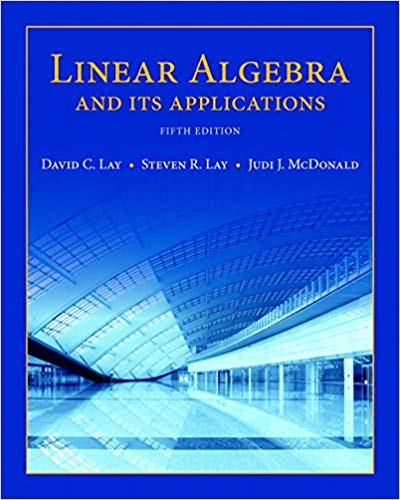
Linear Algebra and Its Applications, 5th Edition
Authors: David C. Lay, Steven R. Lay, Judi J. McDonald
ISBN-13: 978-0321982384
We have solutions for your book!
See our solution for Question 5E from Chapter 1.7 from Lay's Linear Algebra and Its Applications, 5th Edition.
Problem 5E
Chapter:
Problem:
Determine if the columns of the matrix form a linearly independent set. Justify each answer.
Step-by-Step Solution
Given Information
We are given with a matrix A \[A = \left[ {\begin{array}{*{20}{r}}0&{ - 8}&5\\3&{ - 7}&4\\{ - 1}&5&{ - 4}\\1&{ - 3}&2\end{array}} \right]\]We have to find if the columns of the matrix form a linearly independent set.
Step-1: Columns of the Matrix
The columns are given by:\[{a_1} = \left[ {\begin{array}{*{20}{c}}0\\3\\{ - 1}\\1\end{array}} \right],{a_2} = \left[ {\begin{array}{*{20}{c}}{ - 8}\\{ - 7}\\5\\{ - 3}\end{array}} \right],{\rm{ }}\,\,{\rm{and}}\,\,{\rm{ }}{a_3} = \left[ {\begin{array}{*{20}{c}}5\\4\\{ - 4}\\2\end{array}} \right]\]
Step-2: The Augmented matrix
If, the columns are linearly independent, then the equation $Ax=0$ will have only trivial solution. Form an augmented matrix for the equation $Ax=0$\[M = \left[ {\begin{array}{*{20}{c}}0&{ - 8}&5&0\\3&{ - 7}&4&0\\{ - 1}&5&{ - 4}&0\\1&{ - 3}&2&0\end{array}} \right]\]
Step-3: Row-Reduced Augmented matrix
\[\begin{array}{l}M = \left[ {\begin{array}{*{20}{c}}0&{ - 8}&5&0\\3&{ - 7}&4&0\\{ - 1}&5&{ - 4}&0\\1&{ - 3}&2&0\end{array}} \right]\\ = \left[ {\begin{array}{*{20}{c}}1&{ - 3}&2&0\\3&{ - 7}&4&0\\{ - 1}&5&{ - 4}&0\\0&{ - 8}&5&0\end{array}} \right]::\,\,\left\{ {{R_1} \Leftrightarrow {R_4}} \right\}\\ = \left[ {\begin{array}{*{20}{c}}1&{ - 3}&2&0\\0&2&{ - 2}&0\\0&2&{ - 2}&0\\0&{ - 8}&5&0\end{array}} \right]::\,\,\left\{ \begin{array}{l}{R_2} = {R_2} - 3{R_1}\\{R_3} = {R_1} + {R_3}\end{array} \right\}\\ = \left[ {\begin{array}{*{20}{c}}1&{ - 3}&2&0\\0&2&{ - 2}&0\\0&0&0&0\\0&0&{ - 3}&0\end{array}} \right]::\,\,\left\{ \begin{array}{l}{R_3} = {R_3} - {R_2}\\{R_4} = {R_4} - 4{R_2}\end{array} \right\}\\ = \left[ {\begin{array}{*{20}{c}}1&{ - 3}&2&0\\0&2&{ - 2}&0\\0&0&{ - 3}&0\\0&0&0&0\end{array}} \right]::\,\,\left\{ {{R_3} \Leftrightarrow {R_4}} \right\}\\ = \left[ {\begin{array}{*{20}{c}}1&{ - 3}&2&0\\0&1&{ - 1}&0\\0&0&1&0\\0&0&0&0\end{array}} \right]::\,\,\left\{ \begin{array}{l}{R_2} = \dfrac{{{R_2}}}{2}\\{R_3} = - \dfrac{{{R_3}}}{3}\end{array} \right\}\\ = \left[ {\begin{array}{*{20}{c}}1&0&2&0\\0&1&0&0\\0&0&1&0\\0&0&0&0\end{array}} \right]::\,\,\left\{ \begin{array}{l}{R_1} = {R_1} + 3{R_1}\\{R_2} = {R_2} + {R_3}\end{array} \right\}\\ = \left[ {\begin{array}{*{20}{c}}1&0&0&0\\0&1&0&0\\0&0&1&0\\0&0&0&0\end{array}} \right]::\,\,\left\{ {{R_1} = {R_1} - 2{R_3}} \right\}\end{array}\]Thus, there is only one solution of the equation that is: \[{\bf{x}} = \left[ {\begin{array}{*{20}{c}}{{x_1}}\\{{x_2}}\\{{x_3}}\end{array}} \right] = \left[ {\begin{array}{*{20}{c}}0\\0\\0\end{array}} \right]\] Columns are Linearly independent
We are given with a matrix A \[A = \left[ {\begin{array}{*{20}{r}}0&{ - 8}&5\\3&{ - 7}&4\\{ - 1}&5&{ - 4}\\1&{ - 3}&2\end{array}} \right]\]We have to find if the columns of the matrix form a linearly independent set.
Step-1: Columns of the Matrix
The columns are given by:\[{a_1} = \left[ {\begin{array}{*{20}{c}}0\\3\\{ - 1}\\1\end{array}} \right],{a_2} = \left[ {\begin{array}{*{20}{c}}{ - 8}\\{ - 7}\\5\\{ - 3}\end{array}} \right],{\rm{ }}\,\,{\rm{and}}\,\,{\rm{ }}{a_3} = \left[ {\begin{array}{*{20}{c}}5\\4\\{ - 4}\\2\end{array}} \right]\]
Step-2: The Augmented matrix
If, the columns are linearly independent, then the equation $Ax=0$ will have only trivial solution. Form an augmented matrix for the equation $Ax=0$\[M = \left[ {\begin{array}{*{20}{c}}0&{ - 8}&5&0\\3&{ - 7}&4&0\\{ - 1}&5&{ - 4}&0\\1&{ - 3}&2&0\end{array}} \right]\]
Step-3: Row-Reduced Augmented matrix
\[\begin{array}{l}M = \left[ {\begin{array}{*{20}{c}}0&{ - 8}&5&0\\3&{ - 7}&4&0\\{ - 1}&5&{ - 4}&0\\1&{ - 3}&2&0\end{array}} \right]\\ = \left[ {\begin{array}{*{20}{c}}1&{ - 3}&2&0\\3&{ - 7}&4&0\\{ - 1}&5&{ - 4}&0\\0&{ - 8}&5&0\end{array}} \right]::\,\,\left\{ {{R_1} \Leftrightarrow {R_4}} \right\}\\ = \left[ {\begin{array}{*{20}{c}}1&{ - 3}&2&0\\0&2&{ - 2}&0\\0&2&{ - 2}&0\\0&{ - 8}&5&0\end{array}} \right]::\,\,\left\{ \begin{array}{l}{R_2} = {R_2} - 3{R_1}\\{R_3} = {R_1} + {R_3}\end{array} \right\}\\ = \left[ {\begin{array}{*{20}{c}}1&{ - 3}&2&0\\0&2&{ - 2}&0\\0&0&0&0\\0&0&{ - 3}&0\end{array}} \right]::\,\,\left\{ \begin{array}{l}{R_3} = {R_3} - {R_2}\\{R_4} = {R_4} - 4{R_2}\end{array} \right\}\\ = \left[ {\begin{array}{*{20}{c}}1&{ - 3}&2&0\\0&2&{ - 2}&0\\0&0&{ - 3}&0\\0&0&0&0\end{array}} \right]::\,\,\left\{ {{R_3} \Leftrightarrow {R_4}} \right\}\\ = \left[ {\begin{array}{*{20}{c}}1&{ - 3}&2&0\\0&1&{ - 1}&0\\0&0&1&0\\0&0&0&0\end{array}} \right]::\,\,\left\{ \begin{array}{l}{R_2} = \dfrac{{{R_2}}}{2}\\{R_3} = - \dfrac{{{R_3}}}{3}\end{array} \right\}\\ = \left[ {\begin{array}{*{20}{c}}1&0&2&0\\0&1&0&0\\0&0&1&0\\0&0&0&0\end{array}} \right]::\,\,\left\{ \begin{array}{l}{R_1} = {R_1} + 3{R_1}\\{R_2} = {R_2} + {R_3}\end{array} \right\}\\ = \left[ {\begin{array}{*{20}{c}}1&0&0&0\\0&1&0&0\\0&0&1&0\\0&0&0&0\end{array}} \right]::\,\,\left\{ {{R_1} = {R_1} - 2{R_3}} \right\}\end{array}\]Thus, there is only one solution of the equation that is: \[{\bf{x}} = \left[ {\begin{array}{*{20}{c}}{{x_1}}\\{{x_2}}\\{{x_3}}\end{array}} \right] = \left[ {\begin{array}{*{20}{c}}0\\0\\0\end{array}} \right]\] Columns are Linearly independent